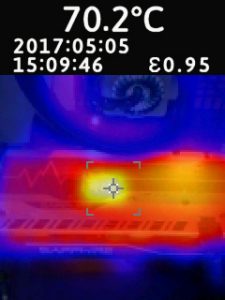Temperatures were measured after 5 minutes of load under three scenario: Furmark, Fire Strike and desktop idle in sequential order with 2 minutes of downtime in between each test. GPU-Z was used to record the maximum temperature, fan profiles on GPUs were left to their default behaviour.
Some cards have no result recorded for the Furmark test, as I found a couple of the cards underclocked themselves to avoid long-term damage, so the temperature levels were much lower.
We present figures as read by GPU-Z (not deltas), and ambient temperature fluctuated between 19-20C during testing.
Most of the aftermarket cards all converge at similar temperatures here, as all of the cards on-test have effective cooling solutions. The Pulse RX 570 is no different, and I did not see the core temperature exceed 74C – and that is with a fan speed of 39% or less, so I would call that a success.
Using our thermal imaging camera, I observed a hotspot behind the GPU core peaking at just over 70C. This is the area where there is a small backplate cut-out, so we are looking right onto the back of the PCB. The rest of the PCB stayed visibly cooler.
 KitGuru KitGuru.net – Tech News | Hardware News | Hardware Reviews | IOS | Mobile | Gaming | Graphics Cards
KitGuru KitGuru.net – Tech News | Hardware News | Hardware Reviews | IOS | Mobile | Gaming | Graphics Cards





Excellent review; and it would be nice to see you you could label the release year of the games you use for benchmarking, as point of reference as well.